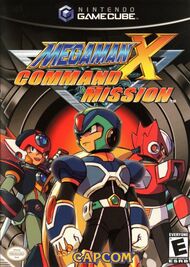| Mega Man X: Command Mission | |

| |
| Developer(s) | Capcom |
| Publisher(s) | Capcom |
| Release date | July 29, 2004 (JP) September 21, 2004 (NA) November 19, 2004 (EU) |
| Genre | Console RPG |
| Mode(s) | Single player |
| Age rating(s) | ESRB: E |
| Platform(s) | PlayStation 2, Gamecube |
| Credits | Soundtrack | Codes | Walkthrough | |
Set in the Mega Man X series, Mega Man X: Command Mission is Capcom's attempt to put Mega Man in an RPG. Given Capcom's lack of experience making Role-Playing Games, MMX:CM represents a lot of innovations in the genre. It also represents a lot of bad ideas.
Story
There's this city, right? Giga City. It's been overtaken by a force calling itself The Rebellion. Their motives are unclear, but it's apparent that they want to unseat the current ruling bodies and take the world for their own. Labelling the Rebellion Maverick, Colonel Redips dispatches ace Maverick Hunters X, Zero, and some jerk named Shadow to investigate.
The situation quickly becomes more desperate, as Epsilon, the leader of the Rebellion, jumps the team and breaks them apart, and by break apart we mean Zero gets conveniently tossed aside, Shadow betrays the Maverick Hunters (surprised?) and X is forced to escape into oblivion. Luckily, X manages to find forces from The Resistance, a small group of Reploids ... resisting the Rebellion, and must put together a small army to try and stop Epsilon.
Along the way, he'll reunite with Zero, and even find his pal Hunter, Axl - as well as a rag-tag cast of new characters, each with their own stories and motives. However, after initial meet-and-greets, there is basically no character development in any part of the game.
Gameplay
Command Mission has no real overworld to speak of. Fairly early in the game X comes to what becomes the hub for the game, from which he embarks upon missions, and has the option of teleporting back to previous mission areas to open new areas and collect more spoils (none of this is necessary for completing the game). The hub is so obfuscatingly organized that travel to anywhere other than your next mission is, well, not really worth searching around for.
In dungeons, X will run down corridors and through doors to try and find a boss or some arbitrary objective depending on the story. The dungeons are very unimaginably designed. There are some puzzles, but very few of them are neurologically stimulating - most are simple tests of skill (which, being an RPG, translates more to a test of statistic points). Random battles are frequent, and always begin with an irritating electric guitar chord.
Conventional console RPGs have players navigate a menu (or successive menus) of choices to execute actions in battle. There are menus in MMX:CM's battle system, but the combat is more reliant on button presses. One button will execute a party member's main attack (based on an equippable weapon), two other buttons will execute secondary attacks (both equippable), another button will activate a special attack (unique to each character), and a final button is used to either access a menu of other options (such as healing through Subtanks or engaging "Hyper Mode"), or cancel a sequence of attacks.
Command Mission's battle system is turn based, depending on characters' speed statistic, e.g. characters will have more frequent turns with higher speed. Each turn, a character has the option of using his secondary attacks and/or main attack, or his special attack, or another menu option. The button-oriented nature of finishing a turn makes attacking very swift, but enemy turns are highly animated, and can sometimes be excruciatingly long.
The limited number of attacks characters can do also limit strategic possibilities in battle. An interesting option is the ability to switch an active party member for an inactive one at the beginning of a character's turn, and this can be used as a "meat shield" technique very well, but unless you plan bothering buying and equipping enough weapons for everyone it's not very useful.
Graphics/Sound
MMX:CM uses cel-shaded graphics, and has a nice, crisp look without impacting system performance. The design is sometimes cool, but usually really weird. The game's soundtrack has some good tracks, but the way the game works, most of them will be played so frequently that subsequent listens will incite aneurysms. The sound effects are largely inconsequential.
Conclusion
Dungeon crawling is pretty boring, and battles aren't terribly exciting too. Overall, Command Mission implemented several new ideas, but in execution it's basically not very fun.
